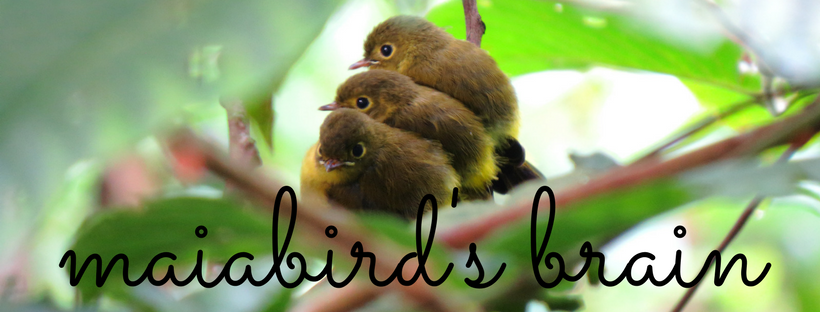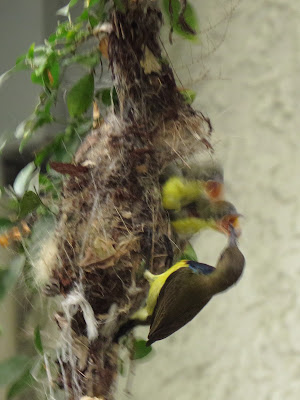Warbler neck refers to the pain you feel in your neck from spending so much time looking up at birds (usually warblers) high up in the trees. Yes, I'm sure many a birder has experienced the stiffness, the pain, and, in my case, the floating black spots and momentary blindness, once you return your neck to its normal position after looong minutes of looking up trying to find a bird in the canopy of trees. I've read it can even cause serious complication in some people! (Birdwatcher's Digest has an article on how to avoid warbler's neck here.)
I definitely felt I was getting warbler's neck when Djop and I went to UP Diliman to check out the Naked-faced Spiderhunters that have been spotted there a few weekends ago. We parked our car and walked to the flowering lipote tree and saw Sir Danny and Sir William already there. No spiderhunter yet, they said, but the area was buzzing with birds!
Orange-bellied Flowerpeckers, Red-keeled Flowerpeckers, and Buzzing Flowerpeckers were busy flying in and out of the lipote tree, feeding on its many flowers.
Even the Yellow-vented Bulbuls and Colasisis took part in the feeding frenzy, landing on nearby trees before flying into the lipote to feed.
 |
| Yellow-vented Bulbul |
 |
| Colasisi as it launches itself into the lipote tree |
There were A LOT of Lowland White-eyes noisily flying about and enjoying the lipote flowers and some Black-naped Orioles kept coming back to partake of the blooms.
 |
| Just one of the many Lowland White-eyes |
 |
| Even the Black-naped Orioles couldn't resist the feast |
After a few minutes, Djop suddenly pointed out the main reason of our twitch: Naked-faced Spiderhunter! It was perched on the leafless tree beside the lipote! I raised my binoculars just in time to see it for a second before it flew into the lipote. Cool! It kept popping in and out of view for a few times, but always high up the leafless tree. We were able to spot two Spiderhunters that morning, but I did not get any decent shot of it. Oh well.
 |
| The ONLY photo I was able to take of the Spiderhunter that morning 😅 |
Our friend Gilbert also popped up to point us to another spot where the Spiderhunters were observed at better vantage points. Sir Danny, Djop, and I waited a while in that area and saw 3 Spiderhunters but they kept to the large trees which gave good views through the binoculars but really bad photos.
We soon said our goodbyes and see-you-soons and finally gave our necks a much-needed rest from all the warbler neck-ing that morning 😁
 |
| Reposting one of my favorite photos: Naked-faced Spiderhunter, 2015 |













